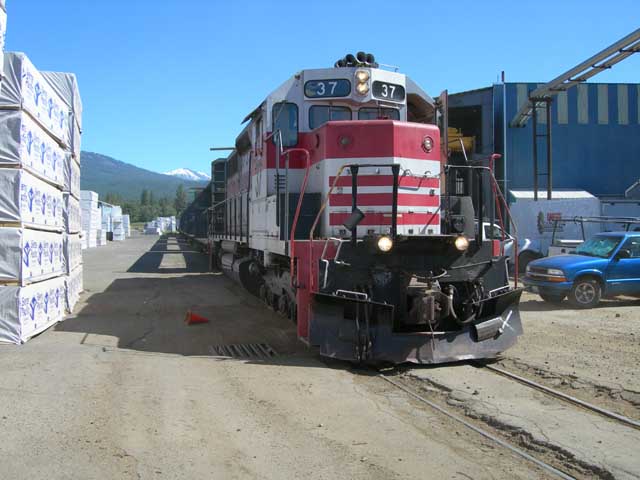|
McCloud Rails : The Last Two Weeks? Page 3 |
|
|
|
|
|
Wednesday, 21 June 2006 |
|
The train crew went to work at 6 a.m. this day, with the remaining employees heading more or less directly from McCloud to the derailment scene. The company made arrangements with Carlton Trucking in Burney for use of their dozer, and by shortly after sunup the crew got to work cleaning up. The first task was to use the dozer to pull the two centerbeams still on the rail backwards and out of the way. The crews then placed the rerailing frogs behind the truck of the centerbeam and then used the dozer to pull it back across the frogs and onto the rail. Once the centerbeam returned to the rail the track crew went to work. They pulled spikes, inserted plugs into the spike holes, used gauge bars to pull the rails back into proper alignment, and then re-spiked the rails down. While the track crew worked Bob drove down to Cayton, fired up the #37, and ran back up the mountain to get the three centerbeams. The tracks had been patched together by the time he arrived, and by noon the #37 was on its way south again with the train. |
 |
|
The #37 rolls south through Cayton, passing between the old section shed on the left and a former Camino Placerville & Lake Tahoe boxcar on the right that Dicalite used to transload bagged Diatomaceous Earth from trucks to railcars in the early years of their reload operation here. |
|
|
 |
|
I passed on the chance to shoot the train at the Lake Britton bridge and instead headed for Arkrite, not far from the top of the grade that lifts the railroad up out of the Pit River Canyon. Arkrite once had a siding that served a snall Ditomaceous Earth shipper in the 1960's, but only concrete foundations remain today to mark the activity that went on there. |
|
|
 |
|
The #37 arrives at a rural crossing not far from Berry. |
|
|
 |
|
In busier times Berry boasted a three track yard and served as the meeting point between the Burney switcher job and the daily road freight that came down from McCloud. Only one siding is left today, and it is significantly shorter than it once was. Seven wreck damaged cars, including four centerbeams and three woochip hoppers, have called Berry siding home since their accidents. One good centerbeam also sat in the siding, and the train paused for just long enough to pick the car up and add it to the consist. |
|
|
 |
|
Once the fourth centerbeam had been added the #37 ran down the main line towards Burney until it had cleared the south leg of the wye. The train then reversed directions and back through the wye and onto the Sierra branch, where it waited...and waited...and waited. A communication breakdown between the other employees meant that no one showed up at Berry to protect the reverse movement down the Sierra branch to the sawmill. Bob finally got in contact with people using his radio and cell phone, and John and Jose started back to help the train out. |
|
|
 |
|
After an hour or so delay John and Jose appear, pick up a portable radio from Bob, and then take up their postions on the rear end to protect the reverse movement. The train starts the seven mile journey to the sawmill and it seen here passing through the area burned over by the Fountain Fire in August 1992. |
|
|
 |
|
Upon arrival at the sawmill the train first backs down through the sawmill complex to the loading dock, where seven loaded centerbeams wait. A new co-generation plant has obliterated much of the trackage the railroad used to be able to use in the plant, which makes the switching more difficult than it used to be. Once the seven loads are hooked together and the air is pumped up the #37 makes a run at the hill and passes back through the entire sawmill complex so that the loads can be set out on the upper siding at the top of the sawmill. The #37 is waiting as John and Jose tie the loaded cars down on the upper siding. |
|
|
 |
|
Once the loads had been tied down the #37 shoves the four empties back to the loading dock where they will be spotted. |
|
|
 |
|
During switching moves the #37 drops down to near the bottom end of the loading dock, which affords this shot of Mount Burney rising in the background. |
|
|
 |
|
Once the empties are spotted and tied down the #37 ran light back up through the sawmill complex to the waiting loads. |
|
|
 |
|
The train departs back up the Sierra branch as soon as the loads are picked up. The front coupler of the #37 makes for an interesting contrast against the roadbed. |
|
|
 |
|
Much of the Sierra branch runs across private land owned by the Denny Land & Cattle Company. This fenceline marks one of the property boundaries. |
|
|
|
|